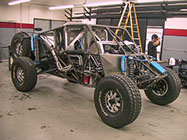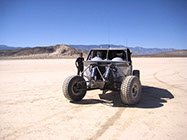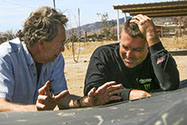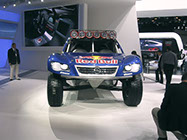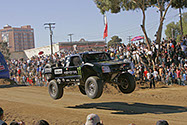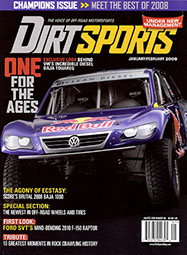TIME LINE

The Trevarri – 1954
Sports Car – 1958
Harris Lotus – 1963
Car “X" – 1964
JP-6 – 1967
The Shadow – 1968
LP Fuel Injection System – 1970
BRE Datsuns – 1971
BRE Formula 5000 Car – 1972
Datsun B210 C Sedans – 1974
The SHADOW Formula 1 – 1978
All American GT Datsun – 1979
The Frissbee CAN-AM – 1979
All American Racers Indy – 1981
VDS-001 CAM-AM – 1980
Galles CAN-AM Champion – 1982
Galles Eagle Indy Car – 1982
Stadium Truck – 1985
Nissan GTP Champions – 1987
Infinity Indy Car Project – 1996
Chevrolet Trophy Truck – 1999
Pflueger Trophy Truck – 2005
Volkswagen Trophy Truck – 2008
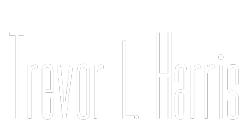
"an innovative engineer
who’s designed some
of the most successful
and iconoclastic racecars
in motor sports history"
Preston Lerner,
Popular Science, 2004
1954 - 1979 SECTIONS

1980 - Present SECTIONS

I have devoted my life to designing vehicles that competed successfully in many
different racing series, including cars, trucks, bikes, and motorcycles. I've enjoyed
inventing, prototyping, and patenting unique bicycles, transmissions and CV joints.
My passion to invent and design continues to race forward.
Below is a historical time line of my accomplishments.
——————————————————————————————————————————————————————————————————————————————————————————————————————————————————————————————————————————————————————————————————————————————————————————————————————————————————————————————————————————————————————————————————————————————————————————
Purchased 1937
Lincoln Zephyr chassis for $15.
Welding fenders at the front curb.
Slow progress.
This car devoured fuel injected
1957 Corvettes!
3/4 view rear.
3/4 view front.
Removed 8 inches from
the Zephyr mid drift.
Test drive.
56 Olds V-8 engine running in front of its future home.
Released from Roosevelt
High School in 1956.
Will the top ever see the
bottom again?
Top half welded to the bottom.
The Trevarri
Harris’ first hot rod. Sectioned and totally modified a 1937 Lincoln Zephyr while in high school.












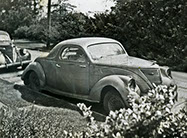
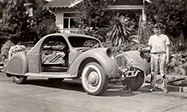
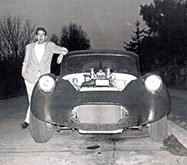
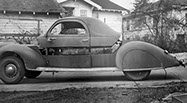
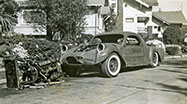
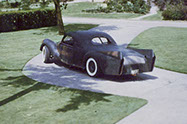
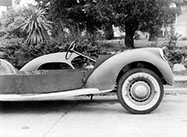
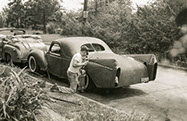
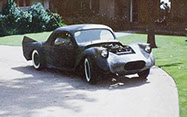
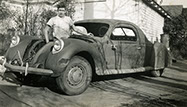
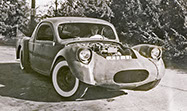
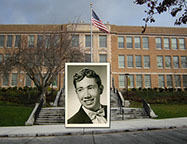

Removed 8 inches from the Zephyr mid drift.
The Trevarri
Will the top ever see the bottom again?
The Trevarri


56 Olds V-8 engine running in front of its future home.
The Trevarri




3/4 view front.
The Trevarri
Released from Roosevelt High School in 1956.
The Trevarri
<
>
11 - 12
x
Harris Sports Car Special
Designed and built a tube frame, full independent suspension sports car “special” and the fiberglass body
for it. Used for street transportation. The car ran 121 mph in the 1/4 mile in 1963.
Harris Sports Car Special under construction in the primordial home garage – 1958.
This wire frame covered with fiberglass and resin was the first step in a one year long body building project.
View seen by many street
racers trying to pass the
Harris Sports Car.
The special runs in early 1959 with a 1935 Maserati F-1 car
front and rear suspension and 18” Borroni wheels and Indy tires.
Two views of the new rear suspension with disc brakes, fabricated in 1963. Note,
the 1935 Maserati Grand Prix
car transaxle.
324 cubic inch Olds engine from the Trevarri with fabricated intake and exhaust manifolds.
Finished body with new suspension parked in shop.
Note the sealed radiator air inlet.
Last picture before car was destroyed by spinning
Shelby King Cobra while parked in pits at Kent in 1964.
Opened Seattle Race Shop
in 1960.
Harris testing the new suspension and body at
the Kent Raceway in 1963.










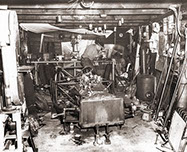
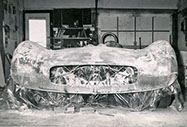
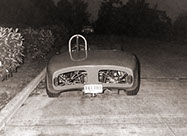
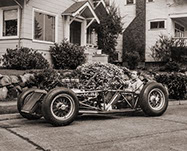
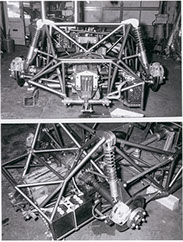
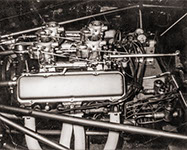
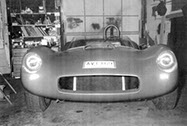
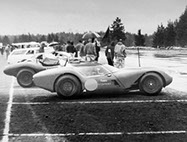
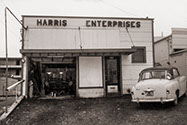
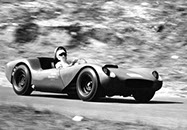










<
>
5 - 10
x
Harris Lotus
Designed and built the rear engine Chevy V-8 “Bardahl Special.” Driven by Jerry Grant in 1964 and 1965.
Qualified on the pole and won it’s first race. It was an extremely modified Lotus 19 with all new Harris rear suspension, plus modified frame and front suspension.






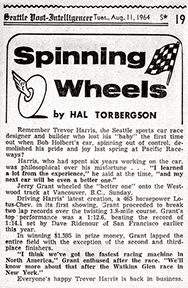
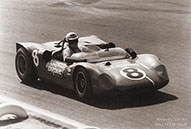
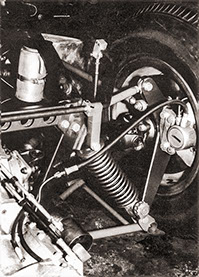
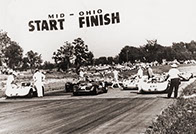
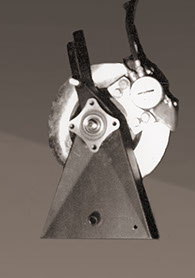
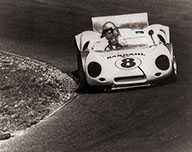






<
>
6 - 6
x
Traco Chevrolet V8 in highly modified Lotus 19. All new
rear suspension and modified
front suspension designed
and built by Harris.
Seattle Post- Intelligencer article documents first win – 1964.
2nd race, Mid-Ohio 1964, qualified 2nd between 2 Chaparrals. Leads 1st 10 laps of race until brakes overheat.
1964 – Leading a Chaparral
at Kent Raceway before
the brakes overheated.
Frame, new rear suspension and hub carrier by Harris.
Gas welded steel rear upright, designed and built by Harris.
Car "X"
Designed and built this very light weight tube frame Can-Am car. Not completed due to monetary deficiencies.
Designed and built by Harris during 1964-66 in Seattle.
Drawing of Car “X” by Harris.
¾ Rear View.
Harris sitting in car.
Harris custom wheel.
Side View.
Rear suspension. Note lower link goes across the car centerline. Zero scrub geometry.
Front Suspension.
Zero scrub geometry.
Side View.
Front View.










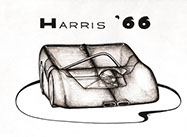
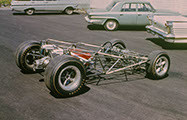
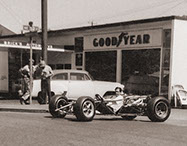
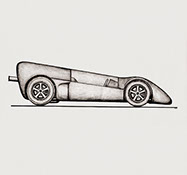
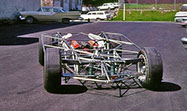
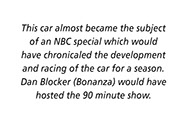
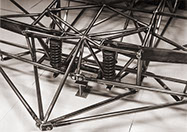
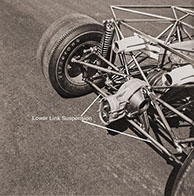
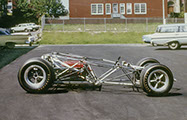
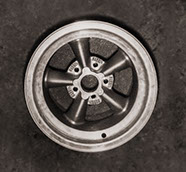
Designed and built by Harris during 1964-66 in Seattle. Drawing of Car “X” by Harris.
Car "X"
Side View.
Car "X"
Front Suspension. Zero scrub geometry.
Car "X"
Side view.
Car "X"
¾ rear view.
Car "X"
Front view.
Car "X"
Rear suspension. Note lower link goes across the car centerline. Zero scrub geometry.
Car "X"
Harris custom wheel.
Car "X"
Harris sitting in car.
Car "X"
Car "X"
<
>
1 - 10
x
Toyota Prototype
Designed and built with partner, Bruce Burness the complete chassis for a Toyota Factory Group 6 prototype sports car. Peter Brock designed the body and subcontracted the chassis design and construction to us.





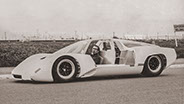
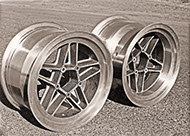
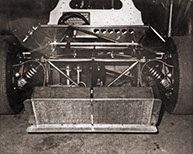
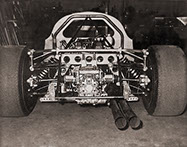
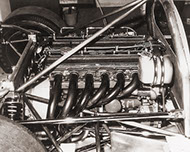





<
>
1 - 5
x
Harris sitting in the rolling Toyota Factory JP-6 prototype coupe.
Mag wheels designed by Harris.
Front suspension.
Zero scrub geometry.
Unique zero scrub rear suspension.
Toyota 2.0 liter 6 cylinder engine. Headers by Harris.
Shadow MK1 CAN-AM Car
Harris conceived and designed the most radical Can-Am car in history, the tiny tired AVS Shadow.











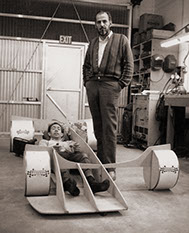
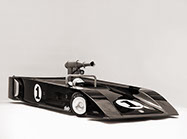
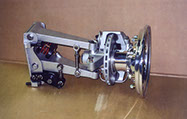
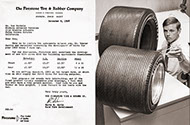
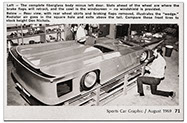
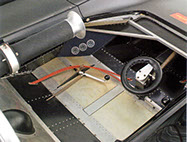
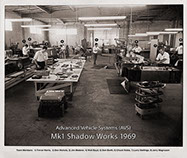
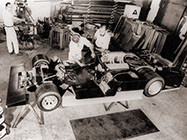
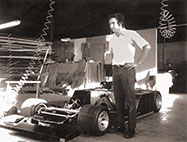
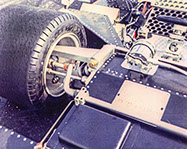
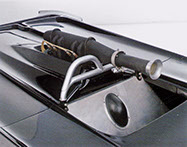
1968 – Early Shadow proposed configuration,
note radiator ahead of right rear tire – Trevor and Don Nichols.
Shadow MK1 CAN-AM Car
Firestone letter of intent to build special tires for the Shadow, Harry Davis testing first articles.
Shadow MK1 CAN-AM Car
The Santa Ana, CA production shop and team. Team Members: 1) Trevor Harris 2) Don Nichols
3) Jim Mederer 4) Walt Boyd 5) Don Borth 6) Chuck Noble 7) Larry Stellings 8) Jerry Magnuson.
Shadow MK1 CAN-AM Car
Right front suspension shows the Spring Pod.
Shadow MK1 CAN-AM Car
The complete car with Trevor at the wheel.
Shadow MK1 CAN-AM Car
Don Nichols in the Shadow Shop.
Shadow MK1 CAN-AM Car
Complete chassis with Larry Stellings (The Silver Fox), and Walt Boyd at the mill.
Shadow MK1 CAN-AM Car
Early inefficient engine air intake.
Shadow MK1 CAN-AM Car
Complete left front suspension with outer wheel half, springs, shocks and brakes.
Shadow MK1 CAN-AM Car
The original Flat 1 spoke steering wheel.
Shadow MK1 CAN-AM Car
Trevor beside Shadow with Toyota V-8 engine. This configuration was not run.
Shadow MK1 CAN-AM Car
<
>
11 - 11
x
1968 – Early Shadow proposed configuration, note radiator
ahead of right rear tire –
Trevor and Don Nichols.
The complete car
with Trevor at the wheel.
Complete left front suspension
with outer wheel half, springs, shocks and brakes.
Trevor beside Shadow with
Toyota V-8 engine.
This configuration was not run.
Firestone letter of intent to build special tires for the Shadow,
Photo of Harry Davis
testing first articles.
Don Nichols in the Shadow Shop.
The original Flat 1
spoke steering wheel.
The Santa Ana, CA production shop and team. Team Members:
1) Trevor Harris 2) Don Nichols
3) Jim Mederer 4) Walt Boyd
5) Don Borth 6) Chuck Noble
7) Larry Stellings
8) Jerry Magnuson.
Complete chassis with
Larry Stellings (The Silver Fox), and Walt Boyd at the mill.
Right front suspension
shows the Spring Pod.
Early inefficient engine air intake.
Don Nichols, Trevor Harris, George Follmer and Walt Boyd testing new aerodynamic configuration.










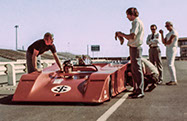
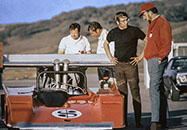
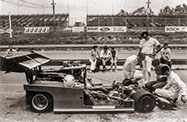

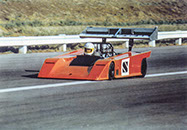
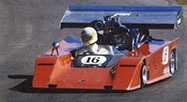
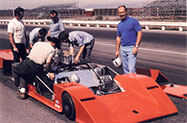
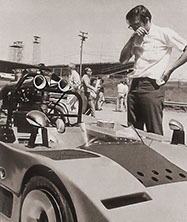
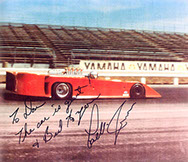
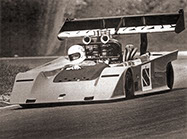



Parnelli Jones testing original car at Orange County Raceway, 1969.
Shadow 2 Testing

Follmer test at Laguna 1970 of unique new wing
– radiator configuration and new Lucas fuel injection.
Shadow 2 Testing




<
>
1 - 10
x
1969 Orange County Raceway. Harris standing to the left of the car. Firestone engineers at left rear. Larry Stellings at car right.
Tire test at Mosport, 1970,
Follmer sitting on left front tire.
Shadow with Internal Wing Radiators, George Follmer –
St. Jovite Race Track 1970..
Early test Orange County, 1969, note vanes in side ducts.
Harris at Riverside pondering
test results.
George Follmer testing
at Laguna Seca.
Parnelli Jones testing original car at Orange County Raceway, 1969.
1969 Orange County test with Parnelli Jones in blue shirt.
Shadow 2 Testing
Shadow testing took place at Orange County Raceway, Riverside, and Laguna Seca.
Follmer test at Laguna 1970
of unique new wing – radiator configuration and new
Lucas fuel injection.
Shadow 3 Press
The Road and Track cover feature on the Shadow caused worldwide interest in this unique car. In addition, this AutoSport cover and story appeared in the same month.





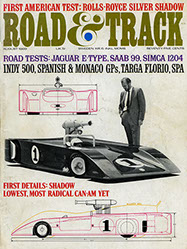
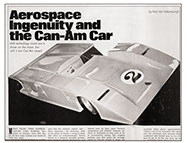
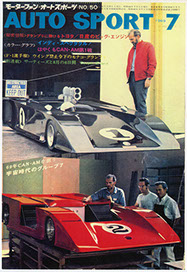
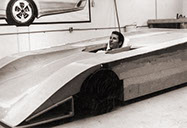
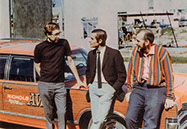
1969 Road & Track cover car which generated worldwide excitement.
Shadow 3 Press
1969 Sports Car Graphic
Shadow 3 Press
Early 1969, Mario Andretti in Shadow mockup.
Shadow 3 Press
Trevor, Jacky Ickyx and Don Nichols discussing the future.
Shadow 3 Press
1969 Japanese cover car. Don Nichols, Don Borth and Larry Stellings examining the car.
Shadow 3 Press
<
>
1 - 5
x
1969 Road & Track
cover car which generated worldwide excitement".
1969 Sports Car Graphic
Early 1969, Mario Andretti in Shadow mockup.
Trevor, Jacky Ickyx and Don Nichols discussing the future.
1969 Japanese cover car.
Don Nichols, Don Borth and
Larry Stellings examining the car.
Low Pressure Fuel Injection System
Harris invented, built, and ran (for 40,000 miles) a novel low pressure fuel injection system for his Firebird.

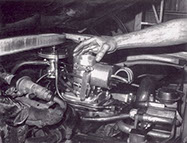
Injector and low pressure regulator mounted on Harris’ 1967 Firebird engine.
Low Pressure Fuel Injection System
<
>
1 - 1
x
Injector and low pressure
regulator mounted on Harris’
1967 Firebird engine.
The BRE 510 Datsun won the 1970 and 1971 2.5 Challenge Series. Team shown with the winning car.
Chronicled in The Stainless Steel Carrot by prize winning author, Sylvia Wilkinson.
Morton driving the Lotus
at Road Atlanta.
The BRE 240Z, driven by
John Morton, won the SCCA C Production National Championship.
John Morton with Trophy
at Laguna Seca.
BRE Formula 5000 Lotus.
John Morton -- Driver,
Trevor Harris -- Chief Mechanic.
BRE Datsuns and Lotus
Harris was Pete Brock’s (BRE) chief chassis designer and racetrack engineer from 1971 to 1972. The boxy modified 510 Datsun production sedans beat the sleeker Alfa Romeo GTA sportscars to win the immensely popular series in both 1971 and 1972 with John Morton driving. The series ended in 1972. Morton also drove the BRE 240Z to the 1970 and 1971 C-Production National Championships at Road Atlanta.






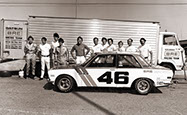
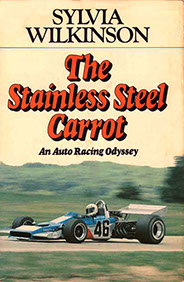
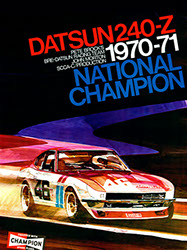
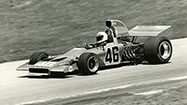
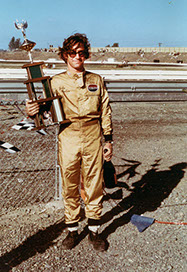
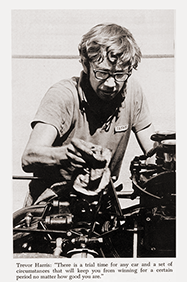
The BRE 510 Datsun won the 1970 and 1971 2.5 Challenge Series.
Team shown with the winning car.
BRE Datsuns and Lotus
The BRE 240Z, driven by John Morton,
won the SCCA C Production National Championship.
BRE Datsuns and Lotus
John Morton with Trophy at Laguna Seca.
BRE Datsuns and Lotus
BRE Formula 5000 Lotus. John Morton -- Driver, Trevor Harris -- Chief Mechanic.
BRE Datsuns and Lotus
Chronicled in The Stainless Steel Carrot by prize winning author, Sylvia Wilkinson.
BRE Datsuns and Lotus
Morton driving the Lotus at Road Atlanta.
BRE Datsuns and Lotus
<
>
6 - 6
x
Harris Vertical Up and Down Pedaling Bicycle
Harris patented and built a compact Up and Down pedaling 20 speed bicycle, “Harris Vertical” bicycle
which received worldwide publicity.
Harris Bicycle related patents.






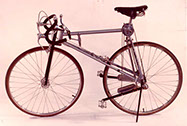
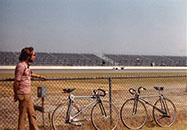
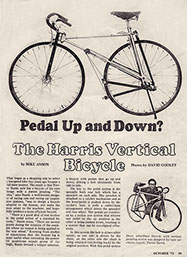
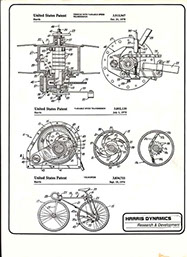
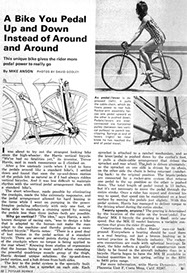
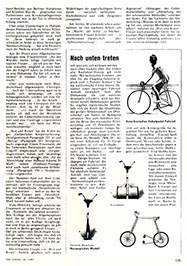
"Harris Vertical” 20 speed version.
Harris Vertical Up and Down Pedaling Bicycle
Bicycling magazine 1973 – original 1 speed version.
Harris Vertical Up and Down Pedaling Bicycle
Popular Science 1974 – This article was picked up by many
other magazines, including Der Spiegel in Germany.
Harris Vertical Up and Down Pedaling Bicycle
Der Spiegel compared the Harris Vertical to other unique concept bikes.
Harris Vertical Up and Down Pedaling Bicycle
Trevor and his ONE-speed and 20-speed bikes at Ontario Speedway 1974.
Harris Vertical Up and Down Pedaling Bicycle
Harris Bicycle related patents.
Harris Vertical Up and Down Pedaling Bicycle
<
>
6 - 6
x
"Harris Vertical”
20 speed version.
Trevor and his ONE-speed
and 20-speed bikes at Ontario Speedway 1974.
Bicycling magazine 1973 – original 1 speed version.
Popular Science 1974.
This article was picked up by many other magazines, including Der Spiegel in Germany.
Der Spiegel compared the
Harris Vertical to other unique concept bikes.
Variable Speed Transmission
Harris patented and built a unique continuous variable speed transmission. He also patented
a bicycle hub using this transmission.



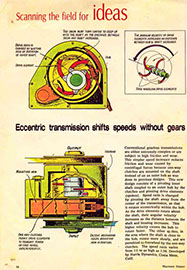
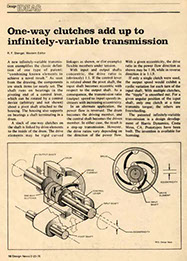
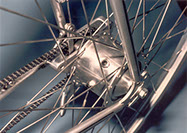
Machine Design article describes “eccentric transmission shifts speeds without gears”.
Variable Speed Transmission
Design News explains the functionality of the Infinitely-variable transmission.
Variable Speed Transmission
1977 – 1978 – Developmental work with Huffy Bicycle Company on
“HARRIS PATENTED CVT BICYCLE HUB” for standard bicycles.
Variable Speed Transmission
<
>
3 - 3
x
Machine Design article describes “eccentric transmission shifts speeds without gears”.
Design News explains the functionality of the Infinitely-variable transmission.
1977 – 1978 – Developmental work with Huffy Bicycle Company on “HARRIS PATENTED
CVT BICYCLE HUB”
for standard bicycles.
The Datsun B210 C Sedans
HARRIS DYNAMICS built 2 factory supported B210 sedans for Dick Davenport and
Frank Carney (Pizza Hut CEO). Davenport won 3 national championships with his car (77, 78,79).


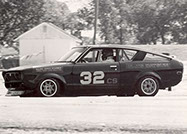
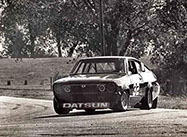
Side view of Davenport winning first race with his B210.
The Datsun B210 C Sedans
Front view of Davenport’s last turn before the checkered flag.
The Datsun B210 C Sedans
<
>
1 - 2
x
Side view of Davenport winning first race with his B210.
Front view of Davenport’s last turn before the checkered flag.
The Shadow Formula 1
Harris was the Shadow Formula One chief designer based in Northampton, UK.





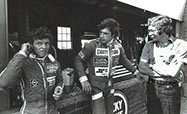
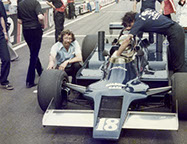
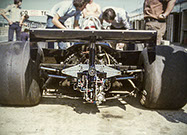
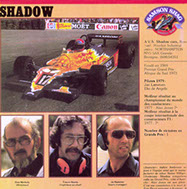
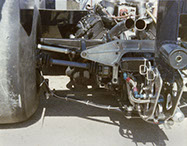
Jan Lammers, Elio de Angelis, Trevor Harris at Belgian Grand Prix 1980.
The Shadow Formula 1
Harris designed new rear suspension. First raced at Silverstone.
The Shadow Formula 1
Shadow was the only Formula 1 team with an American owner and chief designer in 1980.
The Shadow Formula 1
Closeup of rear suspension.
The Shadow Formula 1
Trevor (to left) and chief mechanic, Nigel Stepney leaning over car at Belgian Grand Prix 1980.
The Shadow Formula 1
<
>
5 - 5
x
Jan Lammers, Elio de Angelis, Trevor Harris at Belgian
Grand Prix 1980.
Trevor (to left) and chief mechanic, Nigel Stepney leaning over car
at Belgian Grand Prix 1980.
Harris designed new
rear suspension.
First raced at Silverstone.
Shadow was the only Formula 1 team with an American owner
and chief designer in 1980
Closeup of rear suspension.



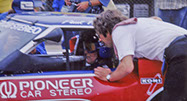
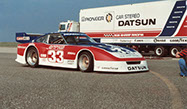
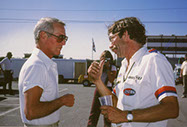
Trevor conferring with driver, Paul Newman.
The Newman Datsun GT
Datsun 33 by the transporter at its first race.
The Newman Datsun GT
Trevor and Newman discussing track adjustments.
The Newman Datsun GT
<
>
3 - 3
x
The Newman Datsun GT
Harris designed the factory supported Turbo V-8 powered GT 280 Datsun built and raced
by the Bob Sharp Racing factory. Driven by Paul Newman and Sam Posey.
Trevor conferring with driver,
Paul Newman.
Datsun 33 by the transporter
at its first race.
Trevor and Newman discussing track adjustments.
The Frissbee CAN-AM
Redesigned with Joe Cavaglieri body and suspension detains on Brad Frisselle’s CAN-AAM Lola.
The car became known as “THE FRISSBEE.



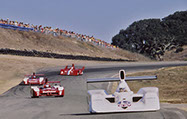
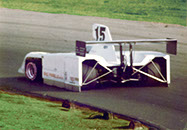
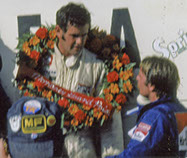
Al Unser Sr. winning Laguna Seca in 1980.
The Frissbee CAN-AM
Early version with sliding skirts (banned in 1980).
The Frissbee CAN-AM
Al Unser Sr in the Winner’s Circle after his only CAN-AM win.
The Frissbee CAN-AM
<
>
3 - 3
x
Al Unser Sr. winning
Laguna Seca in 1980.
Early version with sliding skirts (banned in 1980).
Al Unser Sr in the Winner’s Circle after his only CAN-AM win.




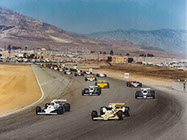
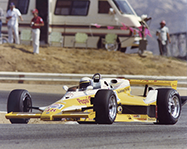
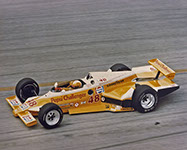
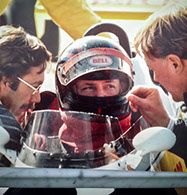




<
>
4 - 4
x
Geoff Brabham qualified on the pole at Riverside 1981. He led the race until a cross-threaded wheel nut put him out at the first pit stop.
Brabham qualifying second
at Mexico City race 1981.
Mike Mosley leading Michigan. The car dropped out of the race with an electrical failure.
Dan Gurney and Trevor debriefing Indy Car Rookie, Rocky Moran before his first Indy car race at Watkins Glen. After a disastrous pit stop fuel spill, Rocky led the race for more than 30 laps before running out of fuel with only a few laps remaining.
All American Racers Indy
Harris became All American Racers chief designer in mid 1981. He engineered the 1980 Eagle
at four racers with three different drivers.
The VDS-001 CAN-AM Champion
Designed a new rear suspension and strengthened the VDS CAN-AM chassis. It won the 1981 CAN-AM series
with Geoff Brabham driving. This car also won the 1984 CAN-AM.



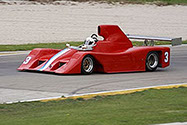
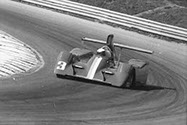
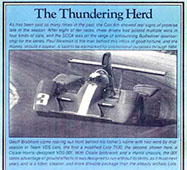



<
>
3 - 3
x
Winning first race at Edmonton 1981, after qualifying on the pole
Mossport 1981.
On Track magazine article
after winning the 1981
CAN-AM championship.
The Galles GR3 CAN-AM Champion
Chief designer for Galles Racing. Harris designed new front and rear suspensions for the
GR3 1982 CAN-AM champion. Driven by Al Unser Jr. this car also won the 1983 and 1985 championships!
Note: Harris chassis won 5 consecutive CAN-AM championships 1981 – 1985.








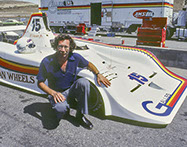
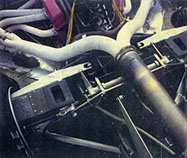
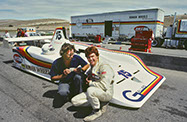
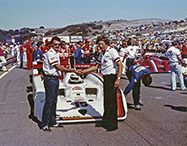
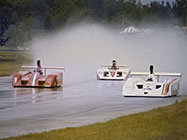
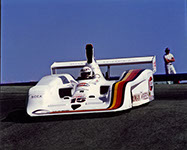
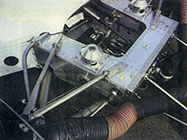
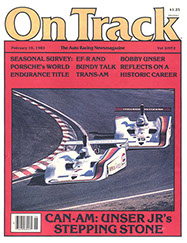








<
>
8 - 8
x
Harris with the new car.
Rear suspension.
Harris and driver, Al Unser Jr.
Shaking hands with team manager Joe Cavaglieri before winning
the 1982 championship
at Laguna Seca.
Leading the VDS car for a win
at Road Atlanta.
Racing to the win at Laguna Seca.
Front suspension..
On Track cover after winning
the championship.
The Galles Eagle Indy Car
Designed the 1983 Galles Eagle Indy Car driven by rookie Al Unser Jr. Qualified 5th at the first race
(1983 Indianapolis) and 2nd at the 2nd race.








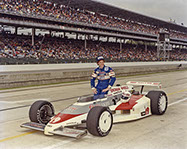
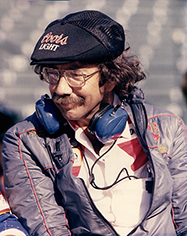
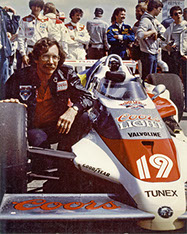
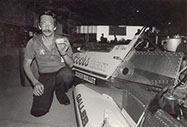
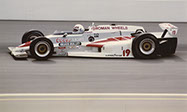

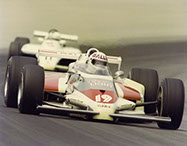
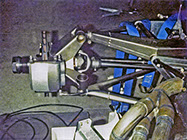








<
>
8 - 8
x
Al Unser Jr. after qualifying 5th at Indy in the car’s first race, and in Trevor’s first Indy 500 race.
Harris takes a moment to think about different set ups for the car.
Getting ready for qualifying at Indy.
Harris beside car with newly introduced insulin pump designed to help control his type 1 diabetes.
On the track during the
Indy 500 in 1983.
Trying to diagnose a problem
in an early test.
Or is it Organic Datalogging?
Rounding one of the many
turns at Indy.
Rear suspension. The only welded steel hub carriers at Indy in 1983. Won the Indiana Oxygen’s
Best Weldment Award for the superior welding on the car.








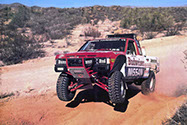
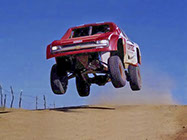
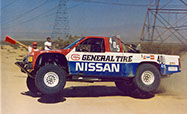
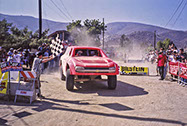
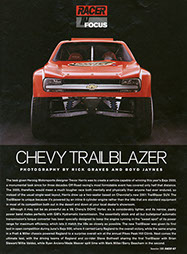
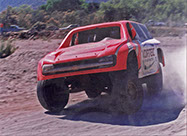
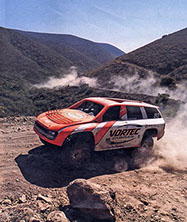
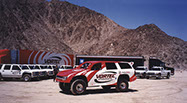








<
>
8 - 8
x
Roger Mears Nissan Class 7 Champion 1986.
Winning the 6-day
Nevada 2000 mile race.
Nissan Class 4 4-wheel drive truck – 2 time national champion – 1988-1989.
Winning the BAJA 500.
Racer magazine feature article
on the BAJA 2000 (2000 miles in the year 2000) Chevy Trailblazer.
Racing in the 2000 BAJA,
finished 2nd and 3rd.
The Trailblazer and its race support truck team.
Chevrolet Trailblazer Trophy Truck (SUV) leading the BAJA 500.
Truck Design and Development 1
The Chevy Trailblazer won the BAJA 500, the Nevada 2000 6 day race. The Trailblazers competed in the 2000 mile BAJA 2000 race and finished 2nd and 3rd overall.
Truck Design and Development 2
Designed the 4-wheel independent suspension rear engine Alan Pflueger Trophy Truck and the
VW Toureg SUV Trophy “Truck” for the factory in 2008.
Pflueger Trophy truck
chassis – 2006.
Dry lake testing of
Audi V-12 diesel engine.
Trevor and Alan Pflueger
plotting for more speed.
On display at the 2008
Los Angeles Auto Show.
Starting the 2007 BAJA 1000
Dirtsports magazine cover
Trophy “Truck” VW Toureq SUV.
The Nissan GTP Champions

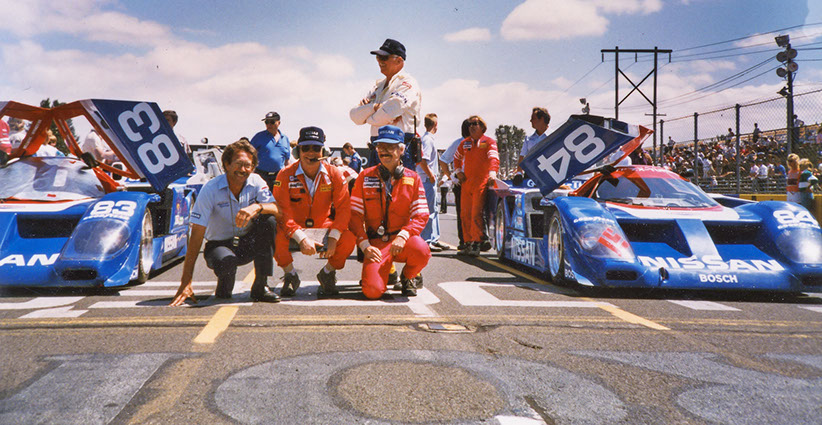








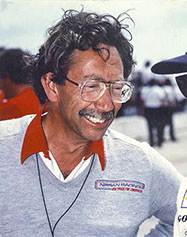
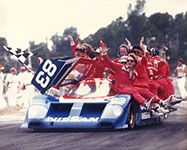
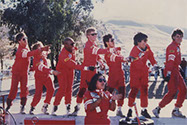
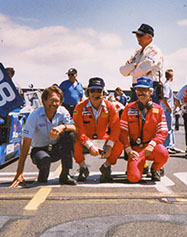
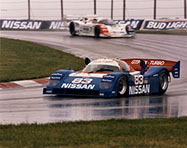
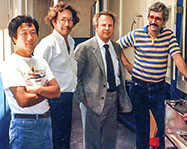
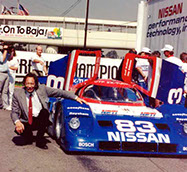
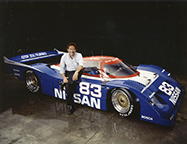
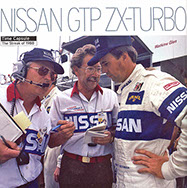
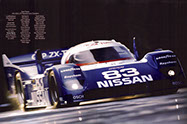








Alice Devendorf and team cheer after West Palm Beach win 1988.
The Nissan GTP Champions
Key members of the NPTI Technical Brain Trust:
Yoshi Suzuka - Aerodynamics, Trevor Harris - Chassis Design and Trackside Engineer,
Don Devendorf - Sr V.P of R&D, Wes Moss - Head of Engineering
The Nissan GTP Champions
<
>
10 - 10
x
Harris designed and track engineered the GTP chassis
for 1988 and 1990 that won
four consecutive championships 1988 to 1991.
Team victory lap after winning
in 1988 at West Palm Beach,
part of an 8 race win streak.
Alice Devendorf and team cheer after West Palm Beach win 1988.
A very wet race win.
Key members of the NPTI Technical Brain Trust:
Yoshi Suzuka - Aerodynamics, Trevor Harris - Chassis Design and Trackside Engineer,
Don Devendorf - Sr V.P. of R&D,
Wes Moss - Head of Engineering
Harris sitting on the ’90 car
after 3rd Sebring 12 hour race
win in a row.
Nissan poster of the 90 car
with all team members listed.
Qualified 1-2 at Portland 1989. Trevor Harris, Don Devendorf, Wes Moss with Kas Kasner,
V.P. of Operations of the team
in the back.
Harris with 1990 car displayed
at Nissan US headquarters.
Geoff Brabham, Trevor Harris,
Don Devendorf discuss setup.

Chief designer and racetrack engineer for the Nissan factory GTP cars that won the top level American sports car championship for four straight years from 1988 to 1991 with Geoff Brabham driving. The Nissan GTP won the Sebring 12 hour race in 3 consecutive years 1990 - 1992 with Geoff Brabham, Derek Daley, John Morton, Bob Earle
and others driving.
The Nissan GTP Champions 2
Harris designed the 2 GTP chassis that won 4 consecutive championships from 1988 to 1992 against
very stiff competition from Jaguar, Porsche, Chevrolet, Mazda, Toyota and Ford factory teams.






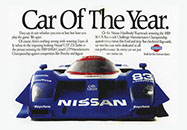
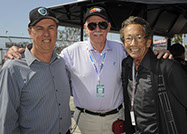
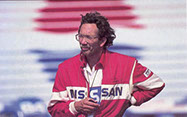
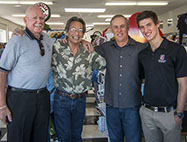
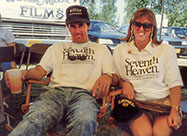
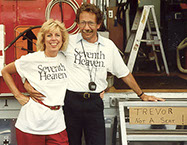
Nissan Corporate demonstrating their pleasure with GTP team during the 1989 season,
posting these bill boards up around the country.
The Nissan GTP Champions 2


Trevor Harris and wife, Freddi Fredrickson enjoy the Seventh Heaven victory celebration.
The Nissan GTP Champions 2


<
>
5 - 6
x
Nissan Corporate demonstrating their pleasure with GTP team during the 1989 season,
posting these bill boards
up around the country.
Kas Kastner, Nissan Head of Motor Sports and Corporate Manager meet up with Geoff
and Trevor at Long Beach many years later while Geoff’s son,
Matt was racing.
A 2015 meeting of Kas, Trevor and Geoff at AutoBooks in Burbank, where Kas was autographing his new Triumph book. Geoff’s son, Matt is on the right.
Harris at the races – photo for 2001 calendar – caption: Chassis designer Trevor Harris is the mastermind behind several Nissan creations, including the GTP ZX Turbos, the Nissan 300 ZX Twin Turbo GTO cars, the TMAC Class 4 off-road truck, and the Roger Mears Racing stadium truck.
Geoff and Rosina Brabham celebrating his 7th win in a row
at Portland, 1988.
Trevor Harris and wife,
Freddi Fredrickson enjoy
the Seventh Heaven
victory celebration.
The Nissan GTO 300ZX Chassis
Designed the factory Nissan 300ZX tube frame GTO chassis that won the 1992 and 1994 championships.
They won the Sebring 12 hour, the Daytona and LeMans 24 hour races in 1994 with drivers,
Steve Millen, Johnny O’Connell and John Morton.

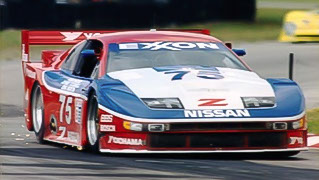

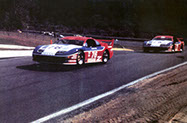

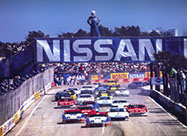
Nissans running 1 and 2 at Lime Rock 1991.
The Nissan GTO 300ZX Chassis
Rounding a turn prior to winning Lemans 24 hour race.
The Nissan GTO 300ZX Chassis
Steve Millen starting from the pole position at Miami 1990.
The Nissan GTO 300ZX Chassis
<
>
1 - 3
x
Nissans running 1 and 2
at Lime Rock 1991.
Rounding a turn prior to winning Lemans 24 hour race.
Steve Millen starting from the pole position at Miami 1990.
Nissan Group C V-12 Chassis Design
Harris is the chief chassis designer of the Nissan V-12 powered Group C car intended
for International racing. Body designed by Yoshi Suzuka.



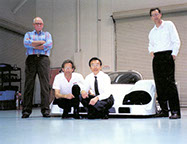
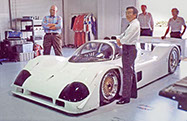
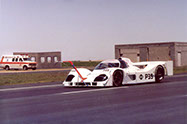
Car parked in NPTI shop, left to right, Kas Kastner, Trevor Harris, Dr. Y Hayashi, Mike Burz.
The Nissan GTO 300ZX Chassis
Three quarter view of Group C car in shop.
Nissan Group C V-12 Chassis Design
Aerodynamic and V-12 engine testing at the Nissan test track in Phoenix 1992.
Nissan Group C V-12 Chassis Design
<
>
1 - 3
x
Car parked in NPTI shop, left to right, Kas Kastner, Trevor Harris, Dr. Y Hayashi, Mike Burz.
Three quarter view of
Group C car in shop.
Aerodynamic and V-12 engine testing at the Nissan test track in Phoenix 1992.
Indy Car Chief Engineer for Comtech
First Honda Indy engine pole at Michigan 1995, 231 MPH with Parker Johnstone driving.
Led for many laps until a rear bearing failed.


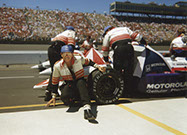
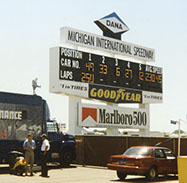
Harris with car at starting grid in pole position.
Indy Car Chief Engineer for Comtech
Scoreboard after qualifying.
Indy Car Chief Engineer for Comtech
<
>
2 - 2
x
Harris with car at starting grid
in pole position.
Scoreboard after qualifying.
Rockshox Downhill Mountain Bicycle
Designed a complete downhill mountain bike for Rockshox, which included a unique new rear suspension.
John Tomac for Giant Bicycles raced it in 1995.



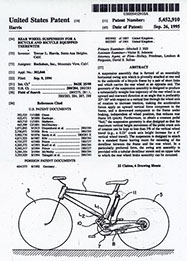
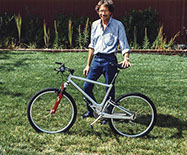
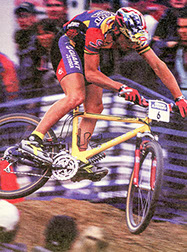
Rear suspension patent.
Rockshox Downhill Mountain Bicycle
Harris with first prototype aluminum frame and rear suspension.
Rockshox Downhill Mountain Bicycle
John Tomac winning the famous ROOSTMASTER Race
for Giant Bicycles in Durango Colorado in 1995.
Rockshox Downhill Mountain Bicycle
<
>
3 - 3
x
Rear suspension patent.
Harris with first prototype aluminum frame and
rear suspension.
John Tomac winning the famous ROOSTMASTER Race
for Giant Bicycles in
Durango Colorado in 1995.
Infinity IRL (Indy Racing League) Engine Installation Package
Worked with IRL Oldsmobile engine designer, Ed Keating to make the Infinity engine interchange
with the Olds using common chassis engine mounting points.


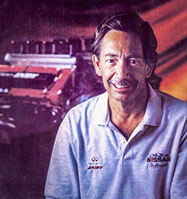
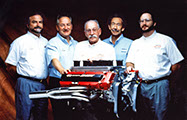
Harris with Infinity engine in the background.
Infinity IRL (Indy Racing League) Engine Installation Package
Frank Honsowetz, Hans Hermann, Ed Pink, Trevor Harris, Clayton Cunningham.
Infiniti IRL Engine Team
Infinity IRL (Indy Racing League) Engine Installation Package
<
>
2 - 2
x
Harris with Infinity engine
in the background.
Frank Honsowetz, Hans Hermann, Ed Pink, Trevor Harris,
Clayton Cunningham
Infiniti IRL Engine Team
Don Nichols Military Amphibious Vehicle
Once again worked with Don Nichols designing and promoting to the US Military
a compact multipurpose amphibious tactical military vehicle.



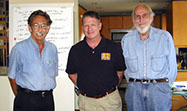
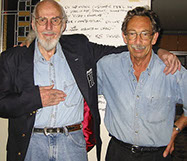
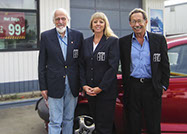
Harris, Bill Shepherd, first commander of the US Space Station and Don Nichols.
The three were discussing an upcoming vehicle meeting at Fort Pendleton in 2003.
Don Nichols Military Amphibious Vehicle
Nichols and Harris swearing to secrecy.
Don Nichols Military Amphibious Vehicle
Don Nichols, daughter and business partner, Penny Nichols, and Trevor
preparing for their promotion to Quantico Marine Corps Base in Virginia.
Don Nichols Military Amphibious Vehicle
<
>
3 - 3
x
Nichols and Harris
swearing to secrecy.
Harris, Bill Shepherd, first commander of the US Space Station and Don Nichols.
The three were discussing an upcoming vehicle meeting
at Fort Pendleton in 2003.
Don Nichols, daughter and business partner, Penny Nichols, and Trevor preparing for their promotion to Quantico Marine Corps Base in Virginia.
Harris High Angle High Torque CV Joint
Designed a new extremely high angle (up to 120+ degrees!), high torque capacity constant
velocity joint (CVJ) for industrial and automotive applications. Worldwide Patents Pending.
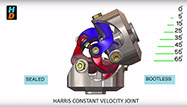
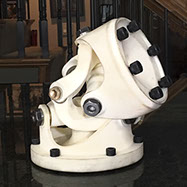
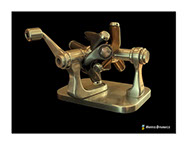
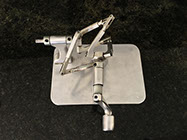
Watch two YouTube videos of the Harris 65-degree and 80-degree CV Joints.
You can also Google “Harris CV Joints".
Harris High Angle High Torque CV Joint
3D printed prototype plastic model of a 5-inch diameter steel joint
that fits a Porsche transaxle. Sealed with no boot – 2600 foot pounds.
Harris High Angle High Torque CV Joint
Handmade (by Harris) early zero to 65-degree angle prototype joint.
Harris High Angle High Torque CV Joint
Very early model of a 110-degree maximum angle (made by Harris).
Harris High Angle High Torque CV Joint
<
>
1 - 4
x
Watch two YouTube videos of the Harris 65-degree and 80-degree CV Joints. You can also Google “Harris CV Joints".
3D printed prototype plastic model of a 5-inch diameter steel joint that fits a Porsche transaxle. Sealed with no boot – 2600 foot pounds.
Handmade (by Harris) early zero to 65-degree angle prototype joint.
Very early model of a 110-degree maximum angle (made by Harris).






